In theory Saturday’s Ironman World Championship should be an easy call. In practice nothing could be further from the truth.
Women’s preview coming later today

Jan Frodeno has beaten Sebastian Kienle twice this season, but that just makes the defending champion even more dangerous.
For well over a decade it’s been pretty easy to at least come up with four athletes who could win the men’s title – it will come out of someone who finished in the top four the preview year. That would put the odds on favorites to be Sebastian Kienle, Ben Hoffman, Jan Frodeno and Andy Potts.
Based on 2015 race results, coupled with his stellar season this year, the Ironman World Championship men’s title will go to Jan Frodeno. Heck, we even profiled the 2008 Olympic champ in our September issue. Even the 2008 Olympic champ doesn’t give much credence to any theory. He is all too aware that a motivated Sebastian Kienle is a scary opponent to have.
“I love a good battle and Sebastian is a great opponent to have,” Frodeno said earlier this week. “I enjoy racing him. Aside from the fact that he’s a good guy, purely as an opponent. He’s awesome because he’s a killer. He goes out there and gets the most of himself when he’s racing. And he’s even more dangerous when he’s angry.”
Why would Kienle be angry? Frodeno spanked him in Frankfurt in July at the Ironman European Championship, riding a stunning 4:08 bike split, then running a 2:50 marathon in 40 degree heat. After years of trying, Frodeno finally took his first world title in Zell am See at the Ironman 70.3 World Championship. Who was second, with the fastest run split of the day? You got it – the defending Ironman world champion.
All of which makes Frodeno obviously very aware that the Kona title on Saturday is very dependent on how he fares over his countryman. And make no mistake, Kienle is motivated to defend his title.
“I think the mix is absolutely perfect,” Kienle said earlier today. “I am the defending champion, I have the confidence … on the other hand Jan has had some absolutely superb performances this year. He beat me two times. In Frankfurt he was in another zip code. That takes away some of the pressure for me. It is also great to have him in the sport. It’s good for your motivation – after the win last year I had to find some new goals. With Jan there you know you can’t take it easy. I want to beat him and that would be the perfect situation for me.”
“I don’t want to call it anger, but sometimes it is good when you’re not happy with your performances,” Kienle continued. “I think the momentum and the strength is going in the right direction. Zell was better than Frankfurt, so I hope that I have some steam left. I have the feeling that I have something left.”
Are the two German’s the only one’s in the field who can win this race? Hardly. Last year’s runner up Ben Hoffman appears to be as fit and ready as ever. Frederik Van Lierde looked simply awesome in winning Ironman South Africa, the Ironman African Championship, in March. While he struggled a bit in Frankfurt, where he finished fifth, that probably had more to do with the state of his training and it’s not always best to be at your fittest in July when you’re gearing up for a race in Kona.
Another man many are watching is Marino Vanhoenacker. Turns out the pain he was suffering in last year’s race was a broken sacrum (that’s a lot of pain …). Since he’s taken time off and let that heal he’s won both Ironman Brazil, the South American Championship and Ironman Austria. He says he’s been lucky twice, no one else is buying that. If Vanhoenacker can somehow figure out how to handle the heat here on Saturday, he could finally have the race we’ve been waiting to see him execute for years.
There’s a lot of excitement on the Canadian side of things, too. Brent McMahon has never done an Ironman in over eight hours. While he’s only done two, that’s still an astonishing feat.
“I am really relaxed and prepared for the course.” the Victoria native said in an interview earlier this week. “I am as ready as I can be for what Kona offers.”
Lionel Sanders is hoping he’s ready to take on the tough conditions here in Kona. He’s been on the island for 19 days now, and is finally getting used to the heat and humidity.
“It was a good decision to come here early,” the Windsor native said in an interview today. “I’ve been here for 19 days and I also did a month of hot training in my training room. Over the last 19 days I’ve seen my heart rate come down on a daily basis. Another thing I’ve done is swim in the ocean every day. I’m swimming well, but I am preparing myself for a deficit. There’s no surprise there, though. Last year at the 70.3 world championship I was last out of the water.”
After dominating the Ironman Asia-Pacific Championship earlier this year, Jeff Symonds has arrived on the island to soak up every bit of the atmosphere in order to learn everything he can about how to succeed here in Kona. He appears to be in great shape, which doesn’t necessarily bode well in this tough event.
The list could go on for a while. Luke McKenzie appears to be really fit right now. The Germans are all talking about Nils Frommhold and Andi Boecherer. Tim O’Donnell lives with the two-time defending champion here in Kona. He duelled with McMahon and Vanhoenacker in Brazil this year, finishing in between the two. Eneko Llanos has left his family at home in order to be better prepared and focus on this year’s race.
Suffice it to say that we’re in for a great day. It is very predictable as to how Frodeno will want to take this race out – a Frankfurt-type race plan is in the cards. The question is if it will work again when you have so many strong athletes ready to attack.
As Sebastian Kienle learned though, the best laid plans can go awry. Welcome to the world of Ironman racing.
Photos: Kevin Mackinnon
Author information
The post Kona Predictions: Men’s Race appeared first on Triathlon Magazine Canada.



























































































